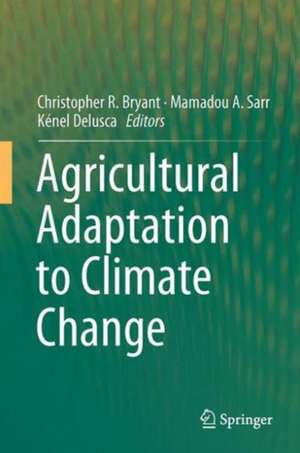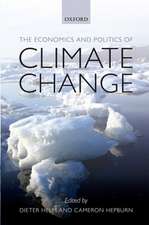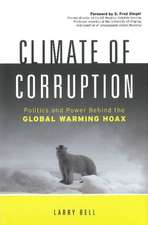Agricultural Adaptation to Climate Change
Editat de Christopher R. Bryant, Mamadou A. Sarr, Kénel Déluscaen Limba Engleză Hardback – 7 sep 2016
The principal argument is threefold: 1) while there are significant differences between territories and countries in terms of the capacity of farmers (and the other actors) to engage in capacity building to be able to adapt effectively to climate change and variability, 2) the critical roles are those played out by the farmers themselves, but that 3) other actors can play an important role in accompanying farmers in their adaptation process, providing relevant and strategic information, counseling them and facilitating networking and meetings when appropriate. This effectively means that without engaging in the local adaptation processes governments can really only play effective roles by working with other actors at the local and regional levels. When it occurs, it can be very effective, but when it does not, farmers are left to their own devices (and even then, many are able to use their own creativity and local knowledge to survive and continue to develop).
Essentially therefore, the secondary argument that is followed throughout the book is that adaptation is essentially a social process that requires an understanding of social processes and dynamics in each farming community and territory. It involves an understanding, for instance, of information diffusion processes in the different farming communities and territories, which provides a set of tools to promote and facilitate the adoption process in the context of adaptation to climate change and variability.
| Toate formatele și edițiile | Preț | Express |
|---|---|---|
| Paperback (1) | 555.67 lei 38-44 zile | |
| Springer International Publishing – 9 iun 2018 | 555.67 lei 38-44 zile | |
| Hardback (1) | 647.40 lei 3-5 săpt. | |
| Springer International Publishing – 7 sep 2016 | 647.40 lei 3-5 săpt. |
Preț: 647.40 lei
Preț vechi: 761.65 lei
-15% Nou
Puncte Express: 971
Preț estimativ în valută:
123.89€ • 134.53$ • 104.07£
123.89€ • 134.53$ • 104.07£
Carte disponibilă
Livrare economică 01-15 aprilie
Preluare comenzi: 021 569.72.76
Specificații
ISBN-13: 9783319313900
ISBN-10: 3319313908
Pagini: 202
Ilustrații: XIII, 234 p. 38 illus., 20 illus. in color.
Dimensiuni: 155 x 235 x 19 mm
Greutate: 0.61 kg
Ediția:1st ed. 2016
Editura: Springer International Publishing
Colecția Springer
Locul publicării:Cham, Switzerland
ISBN-10: 3319313908
Pagini: 202
Ilustrații: XIII, 234 p. 38 illus., 20 illus. in color.
Dimensiuni: 155 x 235 x 19 mm
Greutate: 0.61 kg
Ediția:1st ed. 2016
Editura: Springer International Publishing
Colecția Springer
Locul publicării:Cham, Switzerland
Cuprins
1. Introduction (Christopher R. Bryant).- Part 1. Canada and France.- 2. Agricultural Adaptation to Changing Environments: Lessons Learned from Farmers in Eastern Ontario, Canada (Michael Brklacich).- 3. Social Networks and the Diffusion of Innovative Practices to Help Agriculture Adapt to Climate Change and Variability in Quebec (Omarou Daouda).- 4. Climate Change and Corn Productivity in West Montérégie, Quebec: From Impacts Anticipation to Some Adaptation Potentialities (Kénel Delusca).- 5. The Economic Impact of Climate Change on Cash Crop Farms in Québec and Ontario (Paul Thomassin).- 6. The Organizational Dimensions of Agricultural Adaptation: Experiences in Québec’s Market Garden Sector (Annie Choquette).- 7. Citizen Involvement and Volunteering Along the Acadian Coastline: Challenges for Integrated Management and Adaptation in the Context of Climate Change (Omer Chouinard).- 8. The Contribution of Agronomic Research to Innovation: The Experience of INRA-SAD In France (Christophe Solard).- Part 2. Africa.- 9. Low frequency winter rainfall variability in the North West of Morocco
(Ali Bellichi).- 10. Projections of Peanut Yields from 2011-2040 in Senegal Using Classification and Regression Trees (Mamadou Adama Sarr).- 11. Facing Climate Change through Sustainable Agriculture: Can Results from China be transferred to Africa? (Liette Vasseur).- 12. Adaptation Strategies in the Valley of the Senegal River: A Social Approach to Dealing with Climate Change in Senegal (Gabrielle Tremblay).- 13. Adaptations of the Agricultural Calendar and Agricultural Techniques to Climate Change in the Highlands of Cameroon (Rodrigue Aimé Feumba).- 14. Conclusion (Christopher R. Bryant).
Notă biografică
Christopher Bryant received his doctorate in 1970 atthe London School of Economics and Political Science (LSE), London. He wasprogressively Assistant, Associate and Full Professor in Geography at theUniversity of Waterloo (1970 à 1990), then Full Professor in Geography the Université de Montréal (1990à 2014), and is now Adjunct Profesor in Geography at the Université de Montréaland also in the School of Environmental Design and Rural Planning, Universityof Guelph. He is one of the international leaders in research onurban/periurban agricultures (Canada, Western Europe and elsewhere, and he isalso a recognized leader in the domain of adaptation of human activities (andespecially agriculture) to climate change and variability, in local andcommunity development, and in the strategic planning for local and regionaldevelopment for and by citizens.
Mamadou Adama Sarr received his PhD from the Université JeanMoulin Lyon III, France. His current affiliation is as a Researcher with the Centrede Suivi Écologique, Dakar, Senegal. He was also a post-doctoral Fellow in theLaboratory of Sustainable Development and Territorial Dynamics, Geography atthe Université de Montréal. His research interests are in climatology, climateChange, regional climate modeling, climate variability and extreme, GeographicInformation Systems and Socio-Ecological Systems.
Kénel Delusca holds a Ph.D in geography from the Université de Montréal. Heis currently Adjunct Professor with the Institut des Technologies et des ÉtudesAvancées d'Haïti (ISTEAH). His research interests are: climate changevulnerability assessment, high-resolution climate scenario elaboration, cropmodeling, climate change policy, environmental evaluation, and multi criteriaanalysis.
Mamadou Adama Sarr received his PhD from the Université JeanMoulin Lyon III, France. His current affiliation is as a Researcher with the Centrede Suivi Écologique, Dakar, Senegal. He was also a post-doctoral Fellow in theLaboratory of Sustainable Development and Territorial Dynamics, Geography atthe Université de Montréal. His research interests are in climatology, climateChange, regional climate modeling, climate variability and extreme, GeographicInformation Systems and Socio-Ecological Systems.
Kénel Delusca holds a Ph.D in geography from the Université de Montréal. Heis currently Adjunct Professor with the Institut des Technologies et des ÉtudesAvancées d'Haïti (ISTEAH). His research interests are: climate changevulnerability assessment, high-resolution climate scenario elaboration, cropmodeling, climate change policy, environmental evaluation, and multi criteriaanalysis.
Textul de pe ultima copertă
This book deals with one of themajor challenges facing human society and its governments, climate change andvariability. The principal objective of thebook is to explore how agricultural production through the actions primarily offarmers, including peasant farmers, adapt to these changing circumstances, whatthe limitations of adaptation are, how the process of adaptation varies betweendifferent territories (e.g. developed countries versus developing countries),and what are or can be the most effective roles for actors other than thefarmers, including different levels of government and non-governmentalorganizations (NGOs) such as professional associations of farmers and communityorganizations.
Theprincipal argument is threefold: 1) while there are significant differencesbetween territories and countries in terms of the capacity of farmers (and theother actors) to engage in capacity building to be able to adapt effectively toclimate change and variability, 2) the critical roles are those played out bythe farmers themselves, but that 3) other actors can play an important role inaccompanying farmers in their adaptation process, providing relevant andstrategic information, counseling them and facilitating networking and meetingswhen appropriate. This effectively means that without engaging in the localadaptation processes governments can really only play effective roles byworking with other actors at the local and regional levels. When it occurs, itcan be very effective, but when it does not, farmers are left to their owndevices (and even then, many are able to use their own creativity and localknowledge to survive and continue to develop).
Essentiallytherefore, the secondary argument that is followed throughout the book is thatadaptation is essentially a social process that requires an understanding ofsocial processes and dynamics in each farming community and territory. Itinvolves an understanding, for instance, of information diffusion processes inthe different farming communities and territories, which provides a set oftools to promote and facilitate the adoption process in the context ofadaptation to climate change and variability.
Theprincipal argument is threefold: 1) while there are significant differencesbetween territories and countries in terms of the capacity of farmers (and theother actors) to engage in capacity building to be able to adapt effectively toclimate change and variability, 2) the critical roles are those played out bythe farmers themselves, but that 3) other actors can play an important role inaccompanying farmers in their adaptation process, providing relevant andstrategic information, counseling them and facilitating networking and meetingswhen appropriate. This effectively means that without engaging in the localadaptation processes governments can really only play effective roles byworking with other actors at the local and regional levels. When it occurs, itcan be very effective, but when it does not, farmers are left to their owndevices (and even then, many are able to use their own creativity and localknowledge to survive and continue to develop).
Essentiallytherefore, the secondary argument that is followed throughout the book is thatadaptation is essentially a social process that requires an understanding ofsocial processes and dynamics in each farming community and territory. Itinvolves an understanding, for instance, of information diffusion processes inthe different farming communities and territories, which provides a set oftools to promote and facilitate the adoption process in the context ofadaptation to climate change and variability.
Caracteristici
innovative approach to understanding adaption to climate change Deals with one of society’s key activities, agriculture, which is essential to mankind framework for governments to plan their own roles in the adaptation process Argues thatadaptation is a social process and not just the adoption of technicalsolutions Underscores thecritical importance of farmers and their decision-making environment













